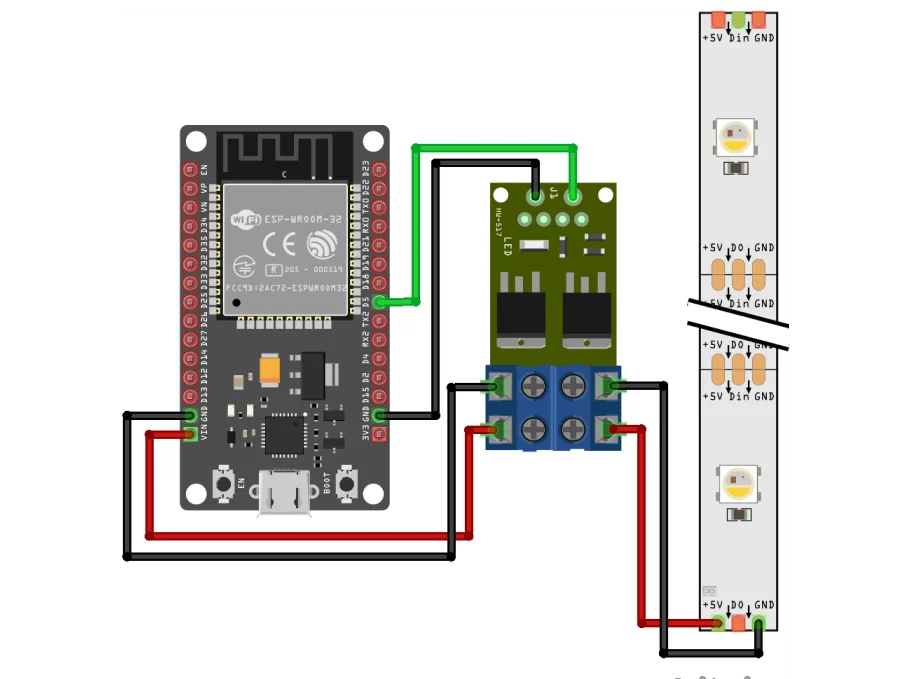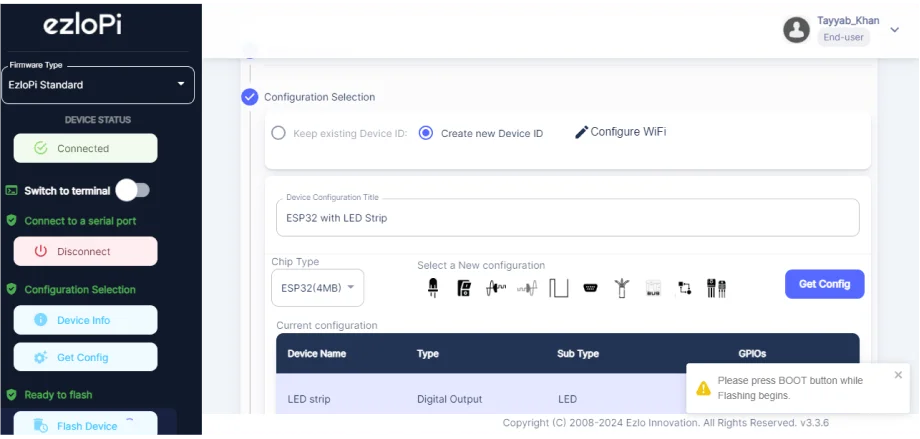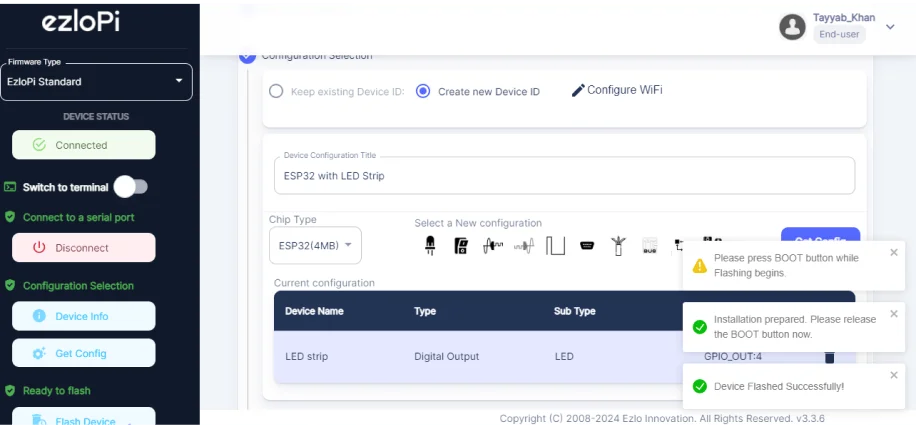
Make your plants grow with EzloPi!
Scheduled lighting for enhancing plant growth
The EzloPi smart devices provide automation through simple, customizable use with our open-source EzloPi platform, making daily life easier and improving human-machine interactions.
Before moving into this example, it is very important to know about the device registration, provisioning and converting the ESP32 device into an EzloPi device along with knowledge of Web Flasher, MiOS Mobile Application for Android/iOS and the MiOS Web Application.
1. About this example
The project aims to optimize plant growth by implementing a scheduled lighting system using the LED strip with the EzloPi device. By leveraging EzloPi's capabilities, the system will automate the timing for plants, mimicking natural sunlight cycles for optimal photosynthesis. Through precise scheduling, it will ensure consistent and appropriate light conditions, promoting healthier and faster plant growth. Additionally, this system will provide remote monitoring and control options, enabling users to adjust settings conveniently from anywhere using the MiOS smart platform. Overall, the project seeks to revolutionize plant cultivation by harnessing the power of technology for enhanced growth and productivity.
2. Project Demonstration Video
Welcome to the project demonstration video section. The following video showcases the key aspects of Scheduled lighting for enhancing plant growth, providing a visual walkthrough of its implementation.
3. Circuit Diagram & Interface
The following components are required for interfacing with the EzloPi device:
- ESP32 as an EzloPi smart device.
- XY-MOS, high-power dual MOSFET driver module.
- Mini portable lamp (24 LEDs).
The wiring diagram is represented as follows:


The following connections are made in order to complete the circuit setup:
From ESP32 to the MOSFET driver module:
| ESP32 | MOSFET driver module |
| D5 | Trig |
| GND | GND |
From MOSFET driver module to LED Strip:
| MOSFET Driver | 24 LEDs mini portable lamp |
| OUT+ | 5V |
| OUT- | GND |
4. Interfacing the MOSFET driver module using the EzloPi Web Flasher
1. Set up your device/hardware by visiting config.ezlopi.com

- Log in using the credentials which you just set earlier while signing up.

- Now, click on the Connect Device button and a pop-up window will appear.

- Now, select COM Port to which your ESP32 device is connected. In our case, the COM3 port is used.
Click Connect

- If you are new to this and it's your first time configuring, select Create new Device ID. Enter Wifi SSID and Wifi Password.
- In the Device Configuration, tab click on Digital Input.

- A Digital Input window will open for inputting the following parameters:
- Set device name to LED strip.
- Set Device subtype to LED.
- Set OUT GPIO to 4.
- Set Resistor to PULL UP.
- Set the default value to LOW.
- Then Click Apply Button.
- After clicking the apply button you can see a table of your setting in the device configuration tab.
- Press the Flash Device button.
- A window will appear on the bottom right side of the screen displaying “Please press BOOT button while flashing begins.”

- Hold the BOOT button down until the next window appears on the bottom right side of the screen which says “Installation prepared. Please release the boot button now.”

- Release the BOOT button from your ESP32 when this pop-up on the bottom right window appears.

- After some time, a popup will appear saying Device Flashed Successfully! This means that your device has been set up successfully.
5. MiOS Web Dashboard
- After configuring the controller with the EzloPi web flasher, head to ezlogic.mios.com

- Use the same credential to log in that you used for configuring the controller with the web flasher.

- After opening the MiOS web dashboard, you will be able to see the tile of your connected device. Currently the tile is OFF, which indicates that the LED strip is OFF and will turn on according to the MeshBot rules which we will configure below.
MeshBots:

- On the right side of the screen under Automation, click on MeshBots.

- On meshbot screen, click on Create new MeshBot button present on the top right corner of the screen.
- After clicking on Create new MeshBot you will see new options, now under Automation MeshBot click on Local.

- On the next screen you will see that we can create a name of our choosing, in this case we write it as Test006.

- In the trigger tab you can set the TRIGGER for your device and in the ACTION tab you can set the action to be performed based on the trigger which you have created.

- Set these values in TRIGGER section:
- Set Node Type to Date and Time.
- Set the Node to Custom time and select the time.
- Set the Value Type to Between.
- Set the Start time to 6:00 pm and Day to everyday.
- Set the Start time to 6:00 pm and Day to everyday.

- Set these values in the ACTION section.
- Click on TRUE.
- Set Node Type to Device.
- Set Controllable Type to LED strip.
- Set the Capability Type to switch.
- Set the Value to true.
- Set Action to immediately.

- Set these values in the ACTION section.
- Click on FALSE.
- Set Node Type to Device.
- Set Controllable Type to LED strip.
- Set the Capability Type to switch.
- Set the Value to false.
- Set Action to immediately.
- Now Click the Save button.

- After clicking the save button you can see this screen on the top right corner of the screen.

- Here you can see your saved MeshBot. Now click on Dashboard.

- Here in the MiOS web dashboard, you can see that when the set time is reached, the LED strip tile turns on because of the meshbot rules.
6. MiOS App
You can download the MIOS Android app from the Google Play Store and Apple App Store.
- After downloading the app, proceed to install the application and open it.

- Using the MIOS mobile application, create a new Ezlo Cloud account using the sign-up option. If you already have an account, you may proceed to log in.

- After successfully logging in, you will be able to see the number of controllers connected such as a lamp, fan, or any other device in the MiOS app. Tap on any controller of your desired ID:

- You will be able to see the status of your controller whether it is online or offline. Access the device dashboard, and tap the device. The following view of the dashboard will appear:

- After opening the MiOS mobile app dashboard, you will be able to see the tile of your connected device.
- Currently the tile is OFF, which indicates that the AC lamp is OFF.

- Similarly, it can be seen that when the set time is reached, the LED strip tile turns ON indicating that the LED strip is also on. This indicates that the rules we have set in meshbot are working.

eZlopie Products A single-channel 5V relay module $00.00

eZlopie Products Momentary switch $00.00

eZlopie Products Level Shifter Module (BSS138) $00.00

eZlopie Products ESP32
$00.00

eZlopie Products AC Lamp and Holder
$00.00












